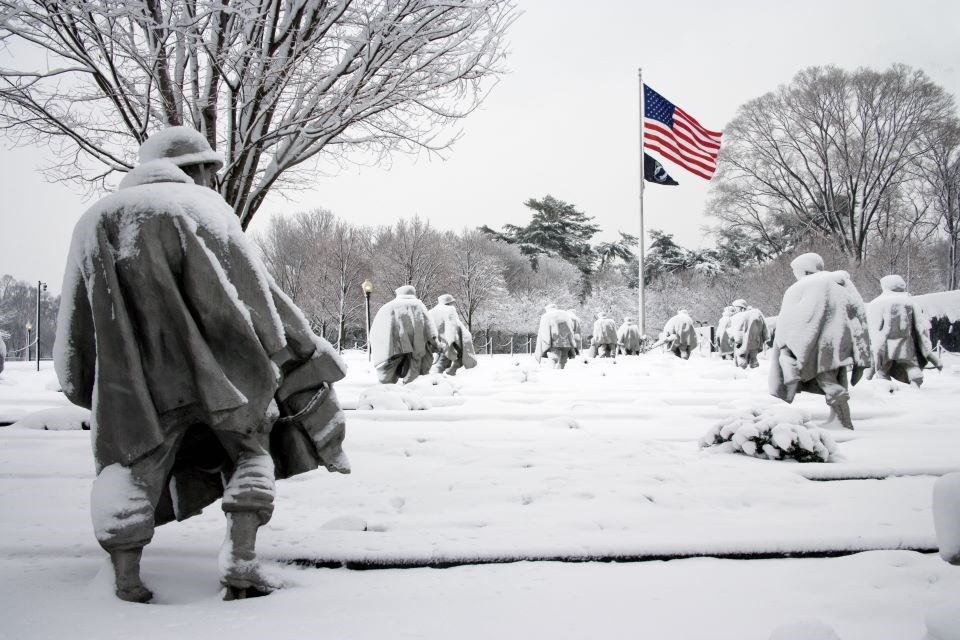
The passing of four decades had brought a new perspective to the war and its aftermath. The time had come, in the eyes of the nation, to set aside a place of remembrance for the people who served in this hard-fought war half a world away. The Korean War Veterans Memorial honors those Americans who answered the call, those who worked and fought under the most trying of circumstances, and those who gave their lives for the cause of freedom. A War Half a World Away Only five years had passed since the end of World War II when the United States once again found itself embroiled in a major international conflict. In the early morning hours of June 25, 1950, the communist government of North Korea launched an attack into South Korea. Determined to support the world’s imperiled democracies, the United States immediately sent troops from Japan to join those already stationed in Korea; the fought with other nations under the U.N. flag. What was envisioned as a short, decisive campaign became a prolonger, bitter, frustrating fight that threatened to explode beyond Korean borders. For three years the fighting raged. In 1953, an uneasy peace returned by means of a negotiated settlement that established a new boundary near the original one at the 38th parallel. One-and-a-half million American men and women, a true cross-section of the nation’s populace, struggled side by side during the conflict. They served as soldiers, chaplains, nurses, clerks and in a host of other combat and support roles. Many risked their lives in extraordinary acts of heroism. Of these, 131 received the Medal of Honor, the nation’s most esteemed tribute to combat bravery. Establishment and Dedication On October 28, 1986, Congress authorized the American Battle Monuments Commission to establish a memorial in Washington, D.C., to honor members of the U.S. armed forces who served in the Korean War. President Ronald Reagan appointed the Korean War Veterans Memorial Advisory Board to recommend a site and design and to raise construction funds. Ground was broken in November 1993. Frank Gaylord was chosen as the principal sculptor of the statues, and Louis Nelson was selected to create the mural of etched faces on the wall. President Bill Clinton and Kim Young Sam, president of the Republic of Korea, dedicated the memorial on July 27, 1995, the 42nd anniversary of the armistice that ended the war. In October 2016, President Barack Obama signed the Korean War Veterans Memorial Wall of Remembrance Act (Public Law 114-2340), authorize the addition of the names of the fallen to the memorial. Construction of the Wall of Remembrance began in March 2021 and will be dedicated on July 27, 2022, the 69th anniversary of the Korean War Armistice Day. A Place for Reflection Viewed from above, the memorial is a circle intersected by a triangle. Visitors approaching the memorial come first to the triangular Field of Service. Here, a group of 19 stainless-steel statues, crated by World War II veteran Frank Gaylord, depicts a squad on patrol and evokes the experience of American ground troops in Korea. Strips of granite and scrubby juniper bushes suggest the rugged Korean terrain, while windblown ponchos recall the harsh weather. This symbolic patrol brings together members of the US Air Force, Army, Marines and Navy; the men are portrayed from a variety of ethnic backgrounds. A granite curb on the north side of the statues lists the 22 countries of the United Nations that sent troops or gave medical support in defense of South Korea. On the south side is a black granite wall. Its polished surface mirrors the statues, intermingling the reflected images with the faces etched into the granite. The etched mural is based on actual photographs of unidentified American soldiers, sailors, airmen and Marines. The faces represent all those who provided support for the ground troops. Together these images reflect the determination of the U.S. forces and the countless ways in which Americans answered their country’s call to duty. The adjacent Wall of Remembrance and Pool of Remembrance, encircled by a grove of trees, provides a quiet setting. The wall includes the names of 36,574 American servicemen and more than 7,200 members of the Korean Augmentation to the United States Army who gave their lives defending the people of South Korea. Numbers of those killed, wounded, missing in action, and held prisoner of war are etched in stone nearby. Opposite this counting of the war’s toll, another granite wall bears a message inlaid in silver: Freedom is Not Free. |
Last updated: July 26, 2022
